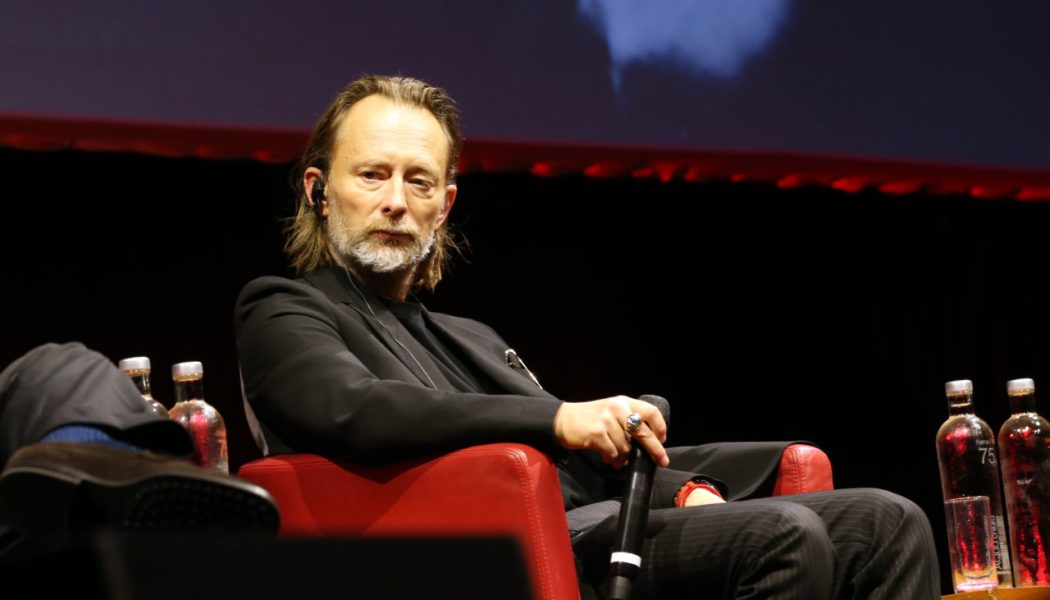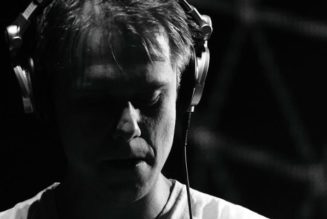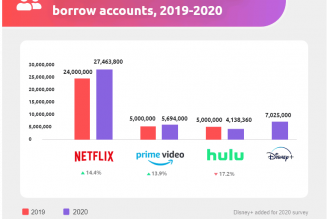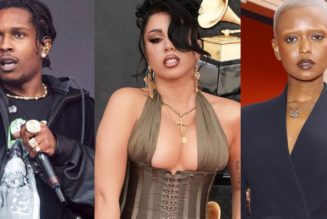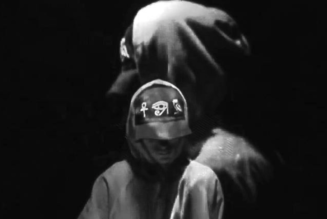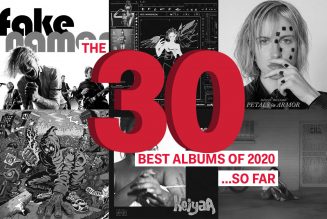It’s become crystal clear this year that without touring revenue, many musicians have little hope of making a living. Streaming royalties are a pittance, and musicians have had to turn to new creative ways to stay afloat. Some sell exclusive vinyl, cassettes, and other merchandise on Bandcamp. Others have turned to the subscription service, Patreon, where fans can pay their favorite creators for access to exclusive content like B-Sides, live sessions, podcasts, and more. But their qualms seem to have fallen on deaf ears at Spotify. All year, the company and its CEO Daniel Ek, have been callous, if not downright contemptuous, towards artists that are trying to eke out a living.
Complaints about Spotify revenue have been floating around for years now. Even in 2013, Radiohead’s frontman Thom Yorke, pulled his solo albums from the platform citing unfair payment. In an interview with Mexican publication Sopitas (original in Spanish & Business Insider in English), he said, “I feel like as musicians we need to fight the Spotify thing.”
The conflict gained new attention in April 2020 when artists began to cancel shows and tours. Spotify introduced a donation button feature for artists to add to their profiles. On the surface, it was a nice gesture that would allow fans to support the musicians they listen to every day. But what comes hand in hand with the button is a tacit admission that their content creators can’t support themselves on revenue from streams alone.
Low stream income is the product of a convoluted and shadowy payment system in which artists receive a proportion of Spotify’s subscription and ad revenue equal to their proportion of streams. First, Spotify takes their 30% helping. The remaining 70% is shared with the countless “rightsholders,” an umbrella term used to describe labels, who often take their own cut and artists. Basically, if everybody decided to listen to nothing but “Yummy” by Justin Bieber for the entirety of 2020, Bieber, and his label, would get the entire 70% cut (what a hellscape that would be).
Spotify, which is the largest music streaming service globally, pulled in $7.3 billion in revenue in 2019. Rightsholders are entitled to $5.11 billion of that revenue. (We did the math, Mr. Ek.) Sounds impressive, but when you split that with the countless artists, and factor in the billions of hours of music people listened to, of course, stream value will be fractions of a cent. Some estimates are as low as $0.003, but given the proportional payout model, it’s difficult to ascertain how much a stream is actually worth. Earlier this year, the classical violinist Tasmin Little revealed in a tweet that she received around $15.50 for over 5 million streams.
Because of their per-stream model, a lot of that slice of the pie goes to the major-label acts. A 2017 Finnish study showed that 10% of all streaming revenue goes to 0.4% of artists, and a 2019 analysis of the market by BuzzAngle found that the 1,000 most streamed songs received almost 20% of streams that year.
While Spotify and its employees certainly deserve to be paid, their alleged $2.85 billion slice of the pie dwarfs the trifling four figures that moderately popular artists would be lucky to receive. In the setting of Ek’s $5 billion net worth, those figures feel grossly unfair and echo the timeless inequality between artists and the people that platform them. Even this year, when so many artists had to resort to scraping by on merch sales, Spotify’s stock value tripled to around $350 a share.
That echo grew stronger in July when Ek told MusicAlly that artists that weren’t “making it” simply weren’t working hard enough. “There is a narrative fallacy here, combined with the fact that, obviously, some artists that used to do well in the past may not do well in this future landscape, where you can’t record music once every three to four years and think that’s going to be enough.”
The remark brought grave criticism from many in the industry and revealed the disconnect between artists and the billionaire software developer that has become the gatekeeper to the industry. Music critic Anthony Fantano released a video in August saying, “As of right now, the financial outlook for musicians when it comes to streaming is looking pretty fucked, and the Spotify CEO is pretty much saying put more music on Spotify, bitch.” A cheeky commenter chimed in, “You can’t make a music app once a decade and think that’s gonna be enough.”
Just four months later, Spotify announced Discovery Mode, a new way for artists to gain exposure on the platform in exchange for a portion of their stream revenue. Music historians immediately drew parallels to the days where labels would bribe radio deejays to give their songs preferential airtime. The practice, termed “payola,” was made a misdemeanor in the 1960s, but apparently that doesn’t apply to the streaming world. Of course, major labels, that already receive preferential treatment on Spotify’s playlists and algorithmic radio, will have no problem paying that fee. Independent and smaller artists will be left further in the dust taking smaller payments or sacrificing exposure, while Spotify further lines its deep pockets.
Throughout these controversies, Spotify has maintained that they are an ally to musicians. But a lack of transparency, coupled with what feels like outright disdain for musicians, just adds insult to injury. I reached out to them for comment, but nobody wanted to go on the record. In press releases and blog posts, they boast that they are democratizing the market place, pointing to the fact that 43,000 artists received 90% of streams. New playlist features and optimized radio algorithms are fanfared as a brilliant tool designed for artists. They shift blame for the poor stream revenue to the labels for taking too large of a cut and wring their hands about how complicated it is to make sure artists get paid.
That is enough for the general populace who pay for the service. Gone are the days of pirating and Limewire, their subscription to Spotify is a totally legal way of listening to music, and therefore it must be fair.
But organizations like the UK Musicians Union, and the Union of Musicians and Allied Workers (UMAW) are gaining traction in counteracting that message. The Broken Record campaign has made great headway in Europe, igniting an inquiry into the streaming industry by England’s Parliament in early December 2020. Tom Gray, founder of the campaign writes, “It is time to meet the challenge of the streaming era, and, at last, create an income stream for artists and performers.” The inquiry is mostly focused on a uniquely British principle called equitable remuneration. It’s a law that grants musicians the rights to royalties when their music is played on the radio or elsewhere in public. Advocates from Broken Record want to extend the reach to streaming.
Unfortunately, the idea of equitable remuneration doesn’t exist in the good ol’ US of A, making the battle that much more uphill. UMAW was formed earlier this year in the States to give performers bargaining power against the likes of Spotify. “We musicians are the original gig-workers,” says Damon Krukowski, ex-member of Galaxie 500, half of the pop duo Damon & Naomi, and an early union member. “An aspect of being an independent contractor is that you have no colleagues obviously. And the music industry has historically encouraged that isolation because it relates to how powerless we are in negotiations. You’re continually in the dark about how to negotiate and your rights and that’s very convenient for a lot of the industry.”
Krukowski said that the union has many objectives, but the most public-facing and highest priority is the Justice at Spotify campaign. Among other demands, UMAW is asking Spotify to pay at least one cent per stream, adopt a user-centric payment model and “reveal existing payola, then end it altogether.”
“Right now, artists have no seat at the negotiating table,” he continues. “Everything is done through the three major labels. There isn’t a contact person for us. There’s no contract for us to sign. You’re either in or out.”
Spotify, of course, doesn’t believe these goals are reasonable, and haven’t been in touch with the union to begin negotiations. Some onlookers might agree because, from the outside, the company doesn’t even seem to be generating a profit. They’ve reported losses for the past three years in the hundreds of millions of dollars. But Krukowski points out that there is an extreme lack of transparency with how Spotify is using its subscription and ad revenue. How does a company that is valued at $46 billion continuously lose money?
As Spotify was telling musicians to essentially beg on their profiles, they signed a $100 million dollar deal for exclusive rights to Joe Rogan’s podcast, making him the most well-paid person on the platform. In order to make the same amount as Rogan, a musician would have to accrue tens of billions of streams. For context, the most-streamed song this year, “Blinding Lights” by The Weeknd, was streamed a little over 1 billion times.
Spotify has made other, aggressive investments in the podcasting world signing contracts with the Obamas and Prince Harry and Meghan Markle. Two contracts that couldn’t have come cheap, and are clear signals to musicians that their needs are secondary, at best. Krukowski also points out that these moves into the podcasting market have insidious undertones. Not only are podcasts cheaper to host because they don’t receive royalties, but they point towards an attitude of market domination.
This is no secret. Ek told CNBC in 2019 that, “it is really about expanding our mission from just being about music to being about all of audio.” This of course means removing competition from the likes of satellite and FM radio, other streaming services and retail. Every one of these represents another stream of income for musicians that is being slowly eliminated.
There are plenty of alternatives to Spotify that prove it’s possible to earn a profit while treating artists equitably. Bandcamp is a prime example of this. The site allows listeners to stream music for free, but also makes it possible for users to buy digital albums, cassettes, vinyl and other merchandise straight from the page.
Even though musicians aren’t getting paid per stream, many end up making more on Bandcamp than they would on Spotify. There isn’t much data confirming this, but some simple napkin math reveals how big the profit margin is between a digital download and a stream. Bandcamp takes a smaller chunk of revenue than Spotify for one, only 10%. Although figures seem to range widely, most seem to agree that a stream on Spotify is worth a third of a cent. So a digital album sold for $15 dollars, a $13.5 share for the artist, would be an equivalent of 4,500 streams.
This year, Bandcamp forwent that processing fee several times. They were dubbed Bandcamp Days, and any purchases made during then would go straight to the artist. In stark contrast with Spotify, Bandcamp only makes money when the artist does through a sale of their music. Their interests are aligned with musicians, while Spotify has little motive to serve its artists as they’ll continue to earn from subscriptions and ads no matter what.
Bandcamp’s payment system is as straightforward and transparent as can be, and they boast a robust artist support team for any issues that may arise. All the while, Bandcamp has consistently made a profit.
Krukowski says another key aspect of the relationship between the musician and Bandcamp is the connection it forms with the audience. Artists can build communities through their Bandcamp pages where fans can send them direct messages, set up email notifications, and sell merchandise alongside their digital albums. “On Spotify we don’t know who’s listening to our music. They keep that data for themselves. How would it hurt Spotify to share that with us?”
There are also cooperatively owned services, like Currents, Resonate and Ampled where artists, listeners and employees all own a stake in the platform. Tidal has guaranteed one cent per stream, and the French streaming platform Deezer has aggressively pursued a user-centric model despite pushback from labels.
There’s an argument that since these alternatives exist, Spotify doesn’t have to change. If people want to support their favorite underground artists they can go buy their album on Bandcamp. But these other platforms exist outside of the mainstream. Streaming now represents 85% of recorded music income and, if an artist wants any chance to participate in the streaming economy, they have to place their music on Spotify. “If you’re a professional, it’s not even really a question,” says Krukowski, “Spotify drives the conversation, but they also pay us the worst.
“Of course this makes it difficult for people to come forward and speak out against them,” he continues, “Not artists, they’re more shoot from the hip people, but labels, managers, and other industry types that can be destroyed by Spotify. We’ve had many artists say they’d like to publicly support our demands, but they’ve been told by their managers not to risk it.”
In 2019, 35% of streams went through Spotify, by far the biggest share, and it doesn’t look like traffic will be redirected to the smaller players anytime soon. Hell, even I use Spotify. As it stands, the examples mentioned earlier are just that, models for how Spotify can operate differently to treat artists more fairly.
As has been made clear this year, Ek and his company have no plans to level the playing field, and, barring some miraculous mass exodus, Spotify is here to stay for the long haul. But they aren’t resistant to pressure, and it is mounting. The inquiry in England could certainly set a precedent here, and the attention that Congress has paid to large tech companies like Google, Amazon and Facebook can easily translate to Spotify.
“If Spotify doesn’t come to the table, that’s probably where we’ll head,” Krukowski ruminates about the future of UMAW. “You can just look at labor history to see what your options are. There’s strikes and there’s legislation. If Ek wants to create a sustainable streaming industry he’ll come to the table. Otherwise, things might start falling apart.”
